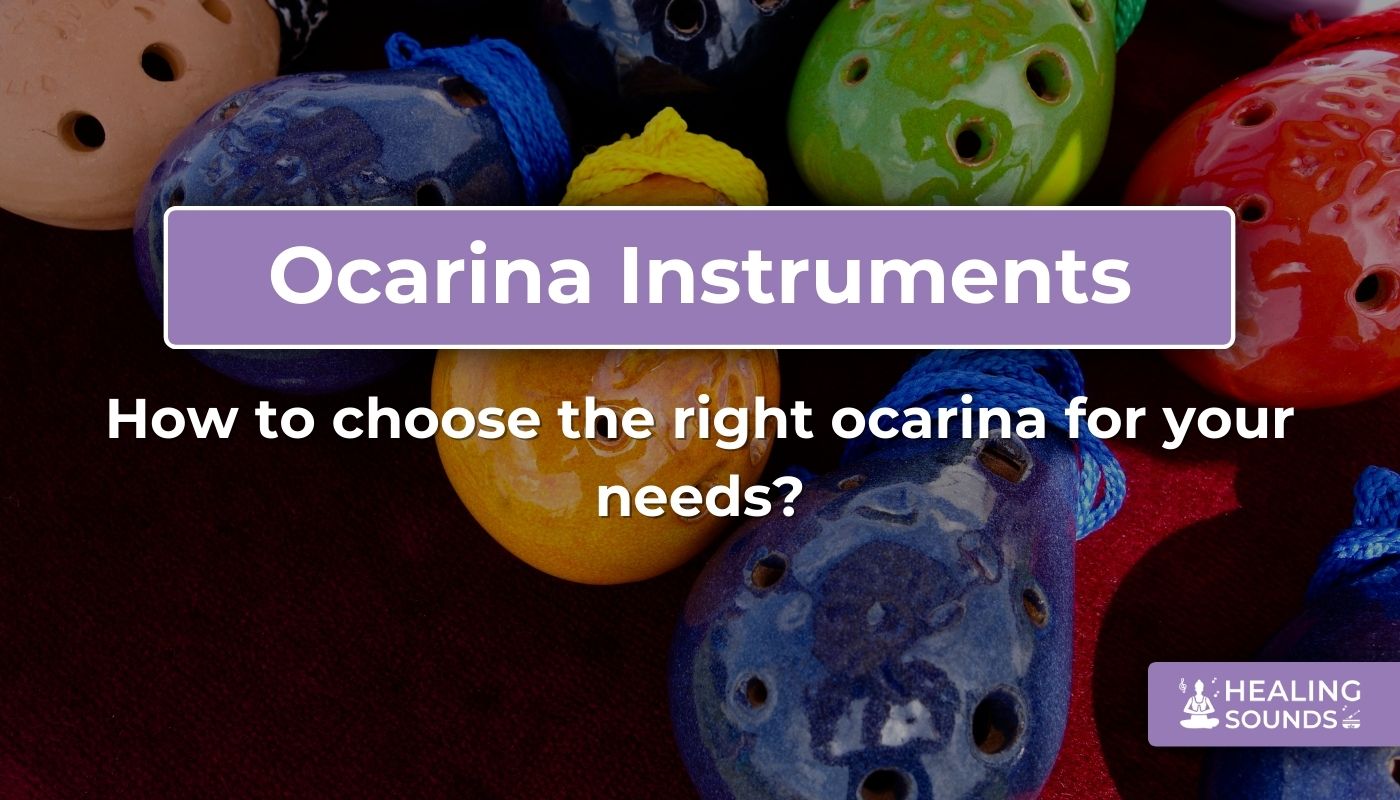Embarking on the journey to find the perfect ocarina can feel magical, like unlocking a piece of ancient history through music. This unique vessel flute, with its captivating sound, appeals to both curious beginners and seasoned musicians. But with various types, sizes, and materials available, how to choose the perfect ocarina that resonates with your musical aspirations? It's a common question for aspiring players and gift-givers alike.
At Healing Sounds, we are passionate about curating exceptional musical instruments from around the world, including a diverse range of high-quality ocarinas. This guide will walk you through everything you need to know to select an ocarina that perfectly suits your needs, skill level, and musical style, ensuring you make an informed and joyful choice.
What Exactly is an Ocarina?
Before diving into selection criteria, let's touch upon what makes the ocarina special. It's an ancient wind instrument, a type of vessel flute, believed to have origins stretching back over 12,000 years. Traditionally shaped like a bird or egg (hence the name, meaning "little goose" in Italian), modern ocarinas come in various forms.
They work by blowing air across a fipple (whistle mouthpiece), creating vibrations within the hollow chamber. Covering different finger holes changes the pitch, allowing melodies to be played. Their haunting, pure tone has enchanted listeners for millennia.
Key Factors When Choosing Your Ocarina
Selecting the right ocarina involves considering several important features. Understanding these will help you narrow down the options and find your ideal musical companion.
Number of Holes: 6 vs 12 (and Beyond)
The number of finger holes directly impacts the ocarina's range and complexity. While simpler 4- or 6-hole models exist (often pendant-style), the most common are:
- 6-Hole Ocarinas: Often recommended for absolute beginners or younger players due to their simplicity. They have a limited range, typically one octave.
- 10-Hole Ocarinas: A good middle ground, offering a wider range than 6-hole but slightly less complex than 12-hole.
- 12-Hole Ocarinas: The standard for many players, offering a chromatic range of about 1.5 octaves (13 notes plus sharps/flats). This versatility makes the 12-hole ocarina suitable for a vast repertoire of music and is often considered the best ocarina for beginners looking to grow.
- Multi-Chamber Ocarinas (Double/Triple): These feature two or three separate chambers and sets of holes, dramatically expanding the range (2-3 octaves). They allow for more complex harmonies and are suited for intermediate to advanced players.
So, should you get a 6 or 12 hole ocarina? If you want maximum musical possibilities and are willing to learn slightly more complex fingerings, the 12-hole is generally recommended. If simplicity is key, a 6-hole might suffice, but you may outgrow it quickly.

12 Hole Alto C Ocarina, Blue & White Porcelain Flute
$29.90 $49.90
A beautiful Alto C ocarina featuring the popular 12-hole design, perfect for learning a wide range of songs with its accessible pitch.
Explore This OcarinaOcarina Types by Pitch: Alto vs Soprano (and Others)
Ocarinas are tuned to different keys, affecting their overall pitch. The most common types are Soprano, Alto, Tenor, and Bass, usually tuned to C or G.
What is the difference between alto and soprano ocarinas?
- Soprano Ocarinas: Produce higher, brighter tones. They are smaller and may require more precise breath control. Often tuned to C (Soprano C) or G (Soprano G).
- Alto Ocarinas: Offer a medium pitch range, often considered mellower and more versatile. The Alto C is a very common choice for beginners due to its comfortable size and balanced tone.
- Tenor Ocarinas: Larger than Alto, producing lower, richer tones.
- Bass Ocarinas: The largest type, offering the deepest sounds.
The choice often depends on personal sound preference and the type of music you wish to play. Alto C is frequently recommended as a starting point.
Material Matters: Ceramic, Porcelain, Plastic, Wood
The material significantly influences the ocarina's sound, feel, durability, and price.
- Ceramic/Porcelain: The traditional choice, prized for clear, resonant tones. Can be fragile if dropped. Quality varies based on clay and firing techniques.
- Plastic: Durable, lightweight, and affordable. Excellent for beginners, children, or travel. Sound quality can be surprisingly good but may lack the richness of ceramic.
- Wood: Offers a warmer, earthier tone. Less common and can be affected by humidity. Requires careful craftsmanship.
Consider where you'll play and your budget. A high-quality ceramic ocarina offers superb sound, while a plastic one provides practicality.
Tuning and Pitch Range
Most ocarinas are tuned to a specific key, commonly C Major or G Major. This determines the base note and the range. A standard 12-hole ocarina tuned to C typically plays from A4 to F6. Understanding the key helps when playing with others or following sheet music.
How Do I Know What Kind of Ocarina I Have?
Identifying your ocarina involves looking at several clues:
- Number of Holes: Simply count the finger holes (excluding the voicing/whistle hole and sound holes).
- Markings: Many ocarinas are stamped with the key (e.g., 'AC' for Alto C, 'SG' for Soprano G) and sometimes the maker's mark.
- Size: Generally, larger ocarinas produce lower pitches (Bass, Tenor), while smaller ones produce higher pitches (Soprano). Alto is typically mid-sized.
- Sound: If unmarked, you can use a tuner app while playing the lowest note (all holes covered) to determine the key.
Choosing Based on Skill Level
For beginners, an Alto C 12-hole ocarina made of plastic or durable ceramic is often the best ocarina for beginners. It offers a good balance of range, ease of play, and affordability.
Intermediate players might explore different keys (like G) a different material (like wood or high-grade porcelain), or consider upgrading to a multi-chamber ocarina for expanded range and harmonic possibilities.
Advanced players often seek out multi-chamber instruments or artisan-crafted ocarinas known for specific tonal qualities or ergonomic designs.
Quick Tips: How to Play Ocarina Properly
- Posture: Sit or stand comfortably upright to allow for good breath support.
- Grip: Hold the ocarina gently but securely, ensuring your fingers can easily cover the holes completely. Use the pads of your fingers, not the tips.
- Breath Control: Use a steady, gentle stream of air from your diaphragm. Blowing too hard produces a sharp, airy sound; too soft sounds weak and flat. Experiment to find the 'sweet spot'.
- Articulation: Use your tongue to start notes cleanly (like saying "too" or "doo").
- Practice Scales: Start with basic scales to develop finger dexterity and learn the note positions.
Consistent practice is key to developing good tone and technique.
Explore High-Quality Ocarinas at Healing Sounds
Finding the right instrument is a personal journey. At Healing Sounds, we offer a curated selection of ocarinas to suit various preferences and skill levels, from accessible beginner models to sophisticated multi-chamber instruments.
Explore Our Diverse Ocarina Collection

12 Hole Soprano Ceramic Ocarina
$24.90
$47.90
Experience bright, high notes with this affordable 12-hole Soprano ocarina, great for adding a higher voice to your music. Learn more ➔

Triple Chamber Alto C Ceramic Ocarina
$99.90
$139.90
Expand your musical horizons with this triple chamber Alto C ocarina, offering an extended range for complex pieces and harmonies. Learn more ➔

21 Hole Alto C Triple Ocarina, Collectible
$269.90
$350.90
A stunning, hand-painted triple ocarina for serious players and collectors, offering exceptional range and craftsmanship. Learn more ➔
Caring for Your Ocarina
Proper care ensures your ocarina sounds its best and lasts for years. Gently wipe it down after playing, especially the mouthpiece, to remove moisture. Store it safely in a padded pouch or case, particularly if it's ceramic.
Avoid extreme temperature changes and direct sunlight. With simple maintenance, your ocarina will remain a reliable musical partner.
For more information on specific instrument care, consider consulting reliable resources like the Encyclopedia Britannica entry on ocarinas for historical context and construction insights.Conclusion: Finding Your Ocarina's Voice
Choosing the perfect ocarina is a rewarding process that balances technical considerations like hole count, pitch, and material with personal preference for sound and aesthetics. Whether you select a simple 12-hole ocarina to start or invest in an advanced multi-chamber instrument, the key is finding one that inspires you to play.
Consider your musical goals, listen to sound samples if possible, and don't hesitate to choose an instrument that speaks to you. Healing Sounds is here to support your musical journey with quality instruments and helpful guidance. We invite you to explore our diverse collection and find the ocarina that will help you create beautiful music.
Frequently Asked Questions about Choosing an Ocarina
For most beginners aiming to play a variety of songs, a 12-hole ocarina is generally recommended. It offers a wider chromatic range (about 1.5 octaves) compared to the 6-hole's limited range (about 1 octave). While a 6-hole is simpler, you might outgrow it faster. The 12-hole provides more long-term potential.
Proper playing involves good posture for breath support, a secure but relaxed grip covering holes fully with finger pads, steady breath control (not too hard, not too soft), clean tonguing to start notes (like saying "too"), and regular practice, starting with scales.
Check for markings indicating the key (e.g., AC for Alto C). Count the finger holes (usually 6, 10, 12, or more for multi-chamber). Note its size (smaller=higher pitch, larger=lower pitch). If unsure, use a tuner app to identify the key by playing the lowest note (all holes covered).
The main difference is pitch and size. Soprano ocarinas are smaller and produce higher, brighter sounds. Alto ocarinas are medium-sized and have a mellower, mid-range pitch. Alto C is a very popular choice for beginners due to its balanced tone and comfortable size.
An Alto C 12-hole ocarina is often considered one of the easiest starting points for beginners aiming to play melodies. 6-hole ocarinas are simpler but more limited. Plastic ocarinas are also easy to handle and durable for learning.
No, plastic ocarinas are generally much more durable than ceramic ones. Ceramic produces a potentially richer tone but can break if dropped. Plastic is ideal for travel, children, or situations where durability is paramount.

